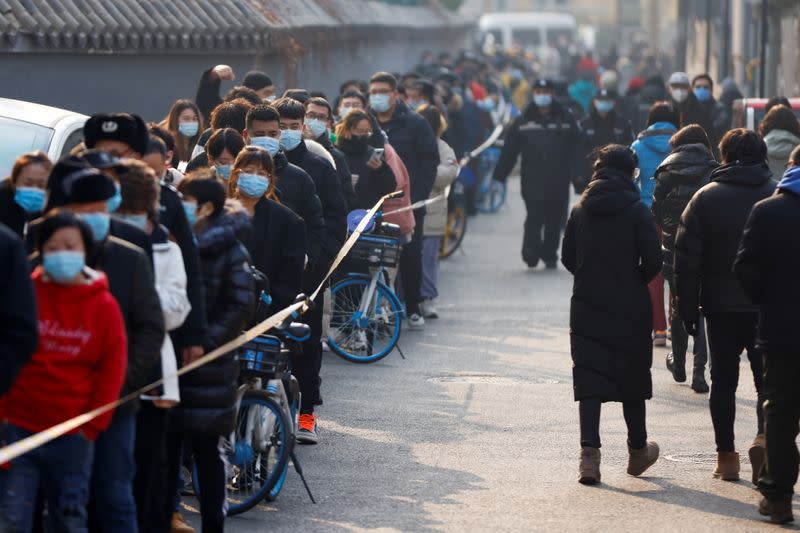BEIJING (Reuters) – Beijing launched mass tests of COVID-19 in some areas on Friday and Shanghai tested all hospital staff as China faced its worst outbreak since March, with families worried about meeting plans for the Lunar New Year amid new restrictions.
Mainland China reported a slight decline in new daily cases of COVID-19 on Friday – 103 out of 144 infections the day before.
Of the new cases, 94 were local transmissions, Heilongjiang province in the northeast reported 47 new cases, while Shanghai reported six new cases and the capital, Beijing, reported three new cases.
Long lines have formed in some districts of Beijing, where mass tests have been launched after several consecutive days of new cases. City officials said there were some “leaks” in controlling the epidemic in some rural areas, with inadequate adherence to the rules on wearing masks, social distance and temperature control.
A line of more than 200 meters formed outside Dengshikou Primary School, a test site near the city center. A man with the surname Lin said the supermarket he works for told him to take a test.
“I am not so worried, although this round of outbreak is a little unexpected. I came as my unit of work told me to do,” he said.
Shanghai began testing all hospital staff for the disease on Thursday, after two of those employees tested positive.
Almost all local transmissions and asymptomatic cases in Harbin, capital of Heilongjiang Province, were linked to a meat processing factory owned by a joint venture between Thailand’s largest agro-industrial conglomerate, the CP Group, and a development zone.
Tens of millions of people are under some kind of blockade in northern cities amid fears that undetected infections could spread quickly during the Lunar New Year holiday in mid-February.
Hundreds of millions of people often travel during the holidays, when migrant workers return to their home provinces to see their family. The authorities expect a large number of travelers, although much less than in normal years.
The northern port city of Tianjin said on Friday that all domestic arrivals would have to have a negative COVID-19 test and be subject to 14 days of home observation.
Hebei province, near Beijing, reported 18 new cases transmitted locally. At the high-speed train station in its largest city, Shijiazhuang, passengers were allowed to get off a train on Friday, but none were seen boarding.
“I never separated from my daughter in the New Year before,” said a woman named Hao in Shijiazhuang, looking after her mother.
She said she was told by her neighborhood that she was not allowed to return to Beijing, where the rest of her family is. She hoped the restrictions would be lifted in time for them to meet for the festival.
She said she was determined to return to Beijing to be with her daughter and that her father was in a nursing home that would not allow more visitors.
The capital’s western train station, which normally receives large numbers of passengers in the run-up to the Lunar New Year, was virtually empty on Friday morning.
The number of new asymptomatic cases, which China does not classify as confirmed cases, rose from 113 cases a day earlier to 119.
The total number of confirmed cases of COVID-19 in mainland China is now 88,804, while the death toll has remained unchanged at 4,635.
(Reporting by Martin Pollard, Sophie Yu, Gabriel Crossley, Roxanne Liu and Beijing editor; Written by Se Young Lee; Edited by Christian Schmollinger, Raju Gopalakrishnan and Karishma Singh)
